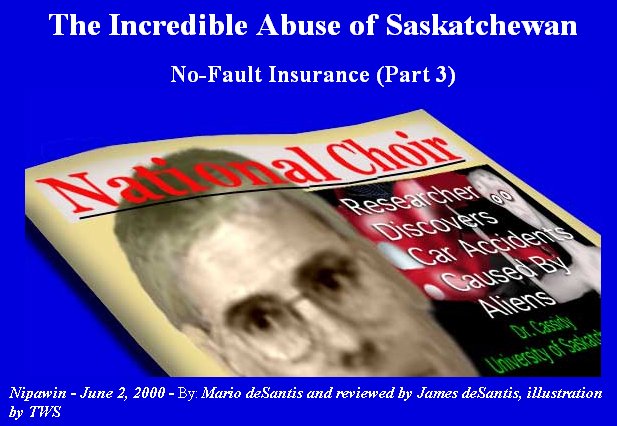Learning Stories
by
Mario deSantis
mariodesantis@hotmail.com
“I am a Canadian, free to speak without fear, free to worship in my own way, free to stand for what I think right, free to oppose what I believe wrong, and free to choose those who shall govern my country.” - -The Rt. Hon. John Diefenbaker, Canadian Bill of Rights, 1960
“The whole judicial system is at issue, it's worth more than one person.”--Serge Kujawa, Saskatchewan Crown Prosecutor, 1991
“The system is not more worth than one person's rights.”--Mario deSantis, 2002
Ensign Stories © Mario deSantis and Ensign
|
|
Dr. Cassidy received a grant in the order of at least a million dollar from SGI There is acknowledged evidence that Dr. Cassidy's research was supported by a grant in the order of at least a million dollar from SGI, a governmental insurance corporation in Saskatchewan. A million dollars is a lot of money, and this amount is quite enough to raise eyebrows about the arm's length relationship between Dr. Cassidy, the University of Saskatchewan, this government and SGI. In this respect, researcher Dr. Marcia Angel has recently stated that "Academic institutions and their clinical faculty members must take care not to be open to the charge that they are for sale(1)." Also, the allegations that Dr. Cassidy's research was blatantly adulterated doesn't sustain the integrity of the authors of this study and the integrity of the conclusions of this same study(2). Changing definitions of whiplash injury, and the proxy of settlement date as the recovery date In the last ten years the definitions and medical treatment of whiplash injuries has been changing. Even today, whiplash injuries and definitions have not been standardized yet to support the so-called objective statistical researches. An article of the insurance and medical paper 'Recovery(3)' published in the Summer of 1999 states that the disparity of incidence of whiplash injuries reported in different studies is "quite likely due to whiplash case definition, how claims are counted (the number submitted versus the number awarded compensation), different claiming incentives in different jurisdictions, and perhaps even different social expectations for compensation . More studies will need to be conducted before we can fully understand these regional variations." The SGI's rehabilitation and medical programs changed during the period of the study conducted by Dr. Cassidy and therefore the changing of these programs affected the recovery time of the injured people. As a consequence, Dr. Cassidy's assumption to equate claim closure with recovery is completely out of place. Dr. Cassidy defends this assumption to equate claim closure to recovery by saying that "we report extensive analysis showing that claim closure is highly associated with improvements in neck pain, physical functioning and depressive symptoms.(4)" The inconsistency with this assumption taken by Dr. Cassisy is further explained by Jon Schubert, Assistant Vice President with SGI. In his letter dated August 1, 1995 directed to Dr. Cassidy, Jon Schubert states "I personally don't think settlement date is a very good indicator of the degree of injury or recovery(5)." There is no doubt that Dr. Cassidy is a reductionist researcher exploiting any minor correlation number he can get from his study and then jump to phony conclusions. In describing how reductionist researchers can come up with phony conclusions, Professor Robert Sternberg says that "anyone who takes statistics knows, you can't draw any real causal conclusions from correlational data. Lots of things correlate with lots of things... To draw causal inferences from correlational data is statistically incorrect... Another thing they do, in comparing correlations, is that they don't take into account the reliability and precision of the measures being used. For example, almost every measure we use is a proxy for something else." References & Endnotes: Quote by Donella Meadows "challenging a paradigm is not a part-time job. It is not sufficient to make your point once and then blame the world for not getting it. The world has a vested interest in, a commitment to, not getting it. The point has to be made patiently and repeatedly, day after day after day" ftp://sysdyn.mit.edu/ftp/sdep/Roadmaps/RM1/D-4143-1.pdf http://iisd1.iisd.ca/pcdf/meadows/default.htm General reference: Articles by Mario deSantis published by Ensign http://www.ftlcomm.com/ensign/authors/desantis.html Dr. Cassidy's study on no-fault insurance: supporting another shock absorber, by Mario deSantis, April 20, 2000 http://www.ftlcomm.com/ensign/desantisArticles/2000/desantis164/nofault.html The fight against No-Fault Insurance is a fight for our Freedom: Attend the Public Forum at the Saskatoon Public Library on May 13, 2000, by Mario deSantis, May 9, 2000 http://www.ftlcomm.com/ensign/desantisArticles/2000/desantis168/Cassidy.html 1. Is Academic Medicine for Sale?, by Marcia Angell, M.D., The New England Journal of Medicine -- May 18, 2000 -- Vol. 342, No. 20, http://www.nejm.org/content/2000/0342/0020/1516.asp 2. Research favoring auto no-fault collides with trial lawyers, Bob Van Voris, The National Law Journal, May 22, 2000, http://www.law.com 3. Leaps and Bounds, Recovery, Volume 10, Number 2, Summer 1999, Insurance Corporation of British Columbia, BC, Canada http://www.icbc.com/oldrecover/Volume10/Number2/articles/bounds.htm 4. Critics should submit own research, Dr. David Cassidy's letter to the Editor, The StarPhoenix, May 17, 2000, Saskatoon, Saskatchewan 5. Letter dated August 1, 1995 from Jon Schubert, Assistant Vice President with SGI, directed to Dr. Cassidy http://www.angelfire.com/nf/coalitionagainstnf/SGI.htm |
